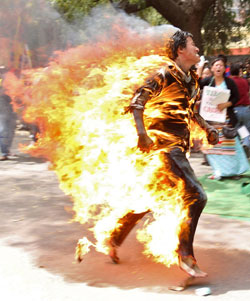Once unheard of in Tibetan society, lighting oneself on fire has become a relatively common form of protest today.

Since March 2009, there have been about 50 self-immolationsin Tibet and ethnically Tibetan areas of China, in protest of China'srepressive policies. But, by most accounts, the repressive policies continue.Tibetan monks are still arrested and "re-educated." They are beatenand forced to denounce the Dalai Lama. They disappear.
Tenzin Dorjee, executive director of Students for a FreeTibet, admits China has intensified its crackdown as a result of theself-immolations. Dorjee says the extreme acts of protest have rallieddisparate parts of the Tibetan diaspora around what he calls the "definingnonviolent movement of our time." Here, Dorjee — a Tibetan born and raisedin exile near Dharamsala, India — explains why he sees the spate ofself-immolations as a success story above all.
What, if anything,has changed as a result of these acts of protest?
Lighting oneself on fire as a political act against theChinese government's rule in Tibet has emerged as the most direct and drasticform of protest. The Chinese government has reacted by intensifying therepression — beating Tibetans while they are still on fire, overseeing amassive security clampdown across Tibet, and behaving in a way that representsthe worst of humanity.
One would expect a greater outcry from the Chinese people tothis crisis but China has turned Tibet into a media black hole and Chinesepeople are given only the government version of the story. Globally, though,we've seen people of conscience responding in many ways — one of which is topledge support for Tibet on the website www.StandUpforTibet.org.
Given that China'srepression has heightened, can we say the self-immolations are a failed tactic?
The self-immolations have succeeded in many ways. Thecurrent wave of self-immolations has ushered in a total and irreversibleawakening of the Tibetan people, built unprecedented unity among the threeprovinces, and returned to Tibetans a proud cultural identity. Theself-immolations have deepened the Tibetan people's capacity for endurance andthus increased the life and strength of the movement.
What will it take forChina to change its ways?
There is one immediate step the world can take to reverseChina's repressive policies: It's the formation of a "Friends ofTibet" contact group, like the Friends of Syria or the Friends of Kosovogroups, focused on resolving the Tibet crisis. Students for a Free Tibet andother groups have been calling for a multilateral approach to nonviolentintervention in Tibet. At this point, the formation of such a group is one ofthe strongest ways to hold China accountable to its policies in Tibet. Thereare many practical ways that governments can pressure China to change its waysand this is where the grassroots public can make a difference by urging theirpolitical representatives to do something. It just takes political will andlittle bit of creativity on the part of those governments.
What's the best wayto tell the story of the Tibetan struggle?
The real story is 6 million people locked in an epic battle— the defining nonviolent movement of our time — for freedom. The best way totell this story is through success. If we can succeed in persuading andpressuring various governments such as Germany, Canada, the US, France, Norway,Czech Republic and others to form a multi-government coalition, a Friends ofTibet contact group, to address the emergency and begin the process of findinga real solution, that will be the victory story that could eventually bring theself-immolations to an end.